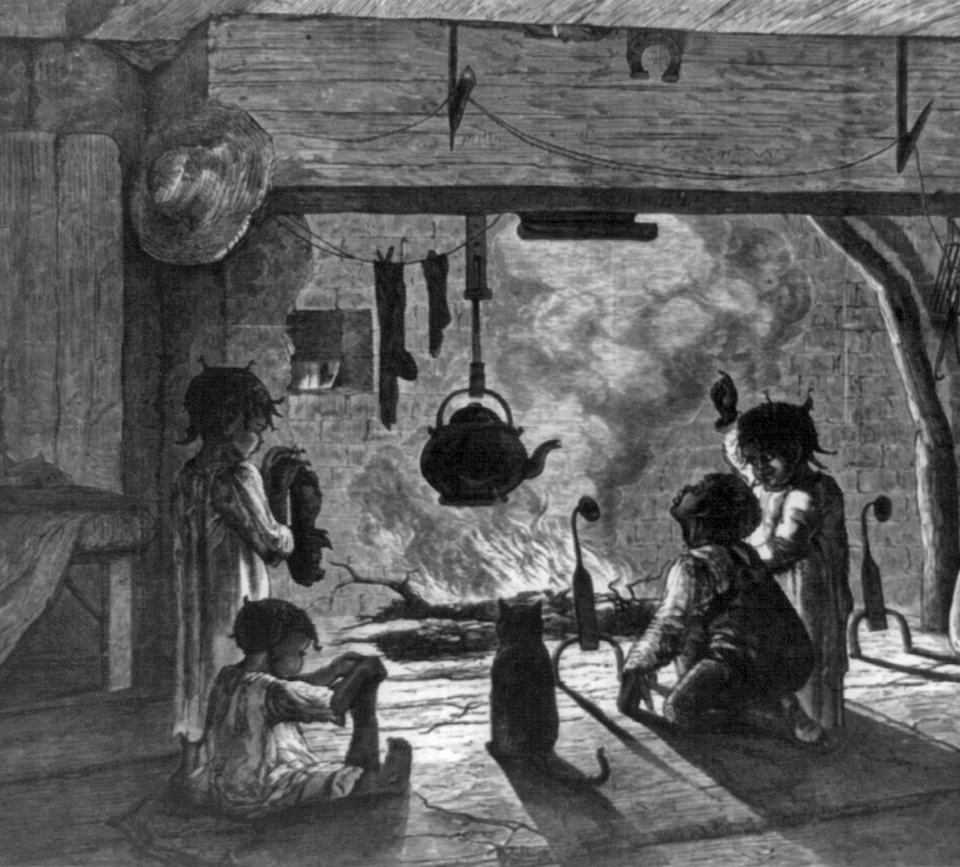Karen McIlvoy, Archaeology Laboratory Supervisor for Thomas Jefferson’s Poplar Forest
The technology to safely cook over an open flame is very old. Cooking pots and utensils with long handles, Dutch ovens, trivets, tongs, and other tools were all used to ensure that cooks were able to prepare food without hurting themselves. One of the tools used that we rarely hear about today is the trammel. A trammel was one of several devices used to hang a cooking pot over a fire. Unlike a traditional pot hook or an S-hook, a trammel consisted of two interlocking iron pieces that slid vertically and locked into place at different points. This allowed the cook to adjust the height of the pot relative to the fire, thus increasing or reducing the heat as needed. Trammels could be made in a range of sizes, from 5 feet to a few inches in length, so they were versatile enough to be used in any size hearth.

A trammel hangs down within the fireplace and holds a kettle above the fire as children gather around it.
Harper’s Weekly
magazine, December 30, 1876.
Ratchet-style trammels (using a series of saw-toothed steps as locks) had been used in Western cooking since at least the Middle Ages. By the 17th century, the pole-and-hole style was more common, in which one piece locks into one of a series of holes punched through the length of the other. Trammels were hung from a wood or iron bar or “lug pole” set inside the chimney. If the lug pole was made of wood, it was most often a sturdy green sapling that would occasionally need to be replaced so that it didn’t dry out or catch fire. By the 1700s, the hinged fireplace crane began to replace the trammel. However, cranes and trammels continued to be used concurrently until they were both replaced by the cast iron stove.
This trammel was found in a root cellar discovered by archaeologists in 1989 beneath the first floor of Poplar Forest’s still standing 1857 Slave Dwelling. It was likely used by the building’s African American residents for cooking in one of the brick hearths set into the building’s single central chimney. During construction, an iron bar was embedded into the chimney stack on at least one side and an iron chain pot hook still remains attached. It is probably that the trammel was suspended from either the same or a similar bar that has since been removed due to 20th century renovations.

Iron trammel found at Poplar Forest, after conservation by Maryland Archaeological Conservation Laboratory.
All metal objects corrode when exposed to oxygen. Water and salt speed up the process. Iron is especially susceptible and in Virginia, where the weather cycles through periods of wet and dry and warm and cold, iron artifacts in the ground rust relatively quickly. Metal artifacts that have been recovered archaeologically must be treated with care in the lab or they will fall apart. They are allowed to dry completely before being stored in special bags to reduce the amount of oxygen exposure. Specialists then use a variety of techniques to chemically stabilize artifacts so they can be better studied, including manually removing corrosion, soaking artifacts in de-ionized water, and passing electrical currents through the objects. This process can take anywhere from weeks to years depending on the details of the artifact. The trammel from the 1857 Slave Dwelling was conserved by the Maryland Archaeological Conservation Laboratory in 2019.
References:
Crump, Nancy Carter. 2009. Hearthside Cooking: Early American Southern Cuisine Updated for Today’s Hearth and Cookstove. University of North Carolina Press: Chapel Hill, NC.
Plummer, Don. 1999. Colonial Wrought Iron. The Sorber Collection.
Image Captions:
Image 1:
A trammel hangs down within the fireplace and holds a kettle above the fire as children gather around it. Harper’s Weekly magazine, December 30, 1876.
Image 2:
Iron trammel found at Poplar Forest, after conservation by Maryland Archaeological Conservation Laboratory.
